Wednesday, 3 December 2025


Exclusive to Agrospectrum, Dr. Nripanka Das, Subject Matter Expert in Carbon Projects (UAE), explains why biochar is emerging as the “engineered permanence” solution in a carbon market searching for credibility, durability, and fair valuation. He highlights biochar’s dual advantage of long-term carbon sequestration and soil regeneration, a combination that delivers stacked financial and agronomic benefits. Scaling beyond pilots, he stresses, will require modular pyrolysis technology, aggregated demand, and blended finance models that de-risk large capital investments.
Dr. Das argues that early movers can benefit from current price volatility by building high-quality, premium projects with strong verification systems. He also emphasizes the leadership role of India and Africa, where agricultural residues, traditional knowledge, and policy momentum could turn these regions into global biochar hubs. Looking ahead to 2035, he envisions biochar credits becoming exchange-traded, fully integrated into national carbon inventories, and a cornerstone of regenerative agriculture worldwide.
Setting the Context – Carbon Market Inflection Point
Carbon markets are undergoing a reset, with debates on credibility, permanence, and fair valuation. Where does biochar sit within this rapidly shifting landscape?
Biochar occupies a unique position in the carbon market reset precisely because it addresses the three core concerns driving this transformation: credibility, permanence and fair valuation. Unlike nature- based solutions that face reversibility risks or technological solutions with high energy penalties, biochar offers what I call “engineered permanence” – carbon sequestration that can be measured, verified and guaranteed for centuries.

From a credibility standpoint, biochar’s carbon accounting is remarkably straightforward compared to forestry projects. We can directly measure the carbon content of the biochar (typically 70-85 per cent by mass), apply well-established permanence factors (0.8-0.95 depending on feedstock and pyrolysis conditions), and calculate net sequestration with minimal uncertainty. The IPCC guidelines provide clear methodologies, and third-party verification is becoming standardized through protocols like Verra’s VM0044 and Gold Standard’s biochar methodology.
The permanence question is where biochar truly differentiates itself. While forest carbon can be released through fires, disease, or land-use change, biochar’s aromatic carbon structure resists decomposition for 100-1000+ years in soil. Recent research using radiocarbon dating of ancient biochar deposits confirms this stability. We’re not dealing with biological permanence that depends on ecosystem management – we’re dealing with chemical permanence based on molecular structure.
Unlike forestry or renewable projects, biochar offers both carbon sequestration and soil regeneration. Do you see this duality as its biggest differentiator in carbon finance?
Absolutely. This duality creates what economists call “stacked benefits” that fundamentally change the value proposition. Traditional carbon projects generate single revenue streams, but biochar creates multiple value cascades: carbon credits, soil productivity improvements, reduced fertilizer requirements, enhanced water retention and often waste management solutions.
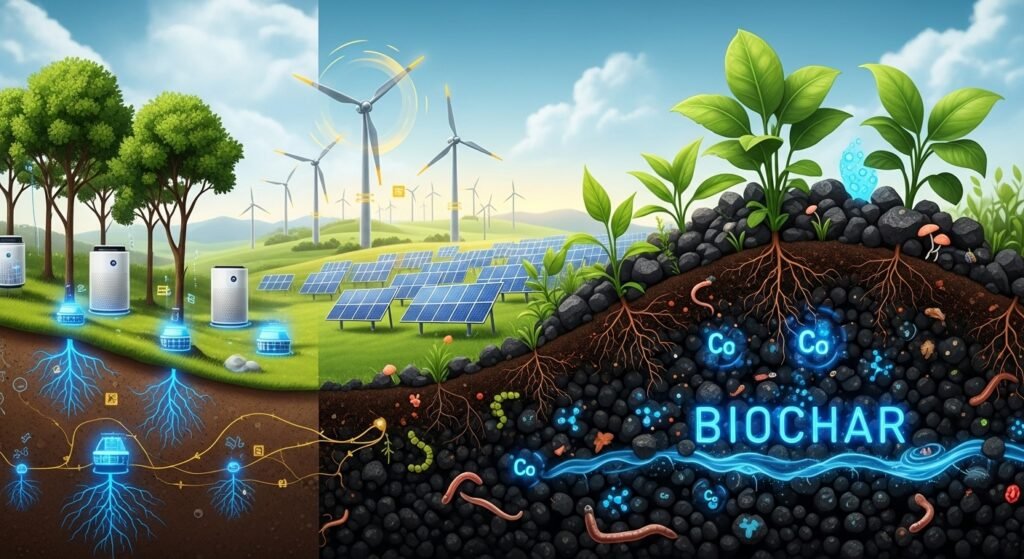
From a financial modeling perspective, this changes the entire risk-return profile. A forestry project might generate $10-50 per hectare annually from carbon credits alone. A well-designed biochar project can generate $50-150 per hectare from carbon credits, plus 10-30 per cent yield improvements worth $200-800 per hectare annually, plus reduced input costs of $50-200 per hectare. The total economic value can exceed $1000 per hectare annually in high-value crop systems.
This stacking effect also provides revenue diversification that reduces project risk. If carbon prices decline, the agricultural benefits maintain project viability. If crop prices fall, carbon revenues provide a floor. This risk mitigation is crucial for attracting institutional capital at scale.
Economics of Biochar – Scaling Beyond Pilots
Many biochar projects remain stuck at the pilot or grant stage. What will it take—policy, price signals, or blended finance—to move biochar into commercial scale deployment?
The scaling challenge is fundamentally about crossing what I call the “commercial valley of death” – the gap between demonstration-scale projects (1-10 tonnes/year) and commercial-scale operations (1000+ tonnes/year). This requires addressing three critical barriers simultaneously.
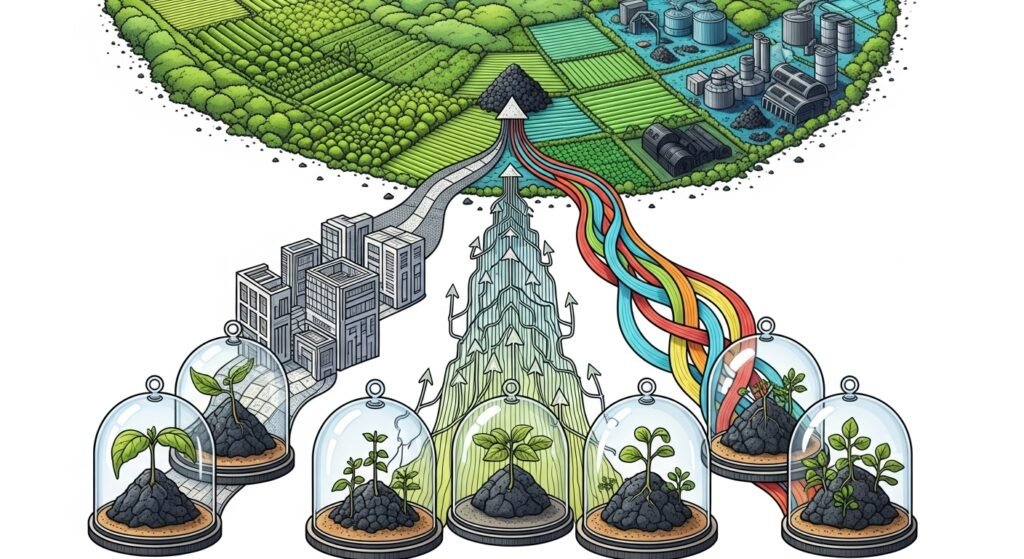
First, we need production cost reduction through economies of scale. Current small-scale pyrolysis systems produce biochar at $800-1500 per tonne. Commercial-scale continuous pyrolysis systems can achieve $300-600 per tonne, but require $2-10 million capital investments. The key is developing modular, standardized systems that can achieve economies of scale while maintaining deployment flexibility.
Second, we need aggregated demand that justifies large-scale production. This means moving beyond individual farm applications to landscape-scale programs. Successful models are emerging in regions like Queensland, Australia, where government programs aggregate demand across thousands of farmers, creating predictable off-take agreements that justify commercial-scale production investments.
Third, we need blended finance structures that address the unique risk profile of biochar projects. These projects have high upfront capital requirements, long payback periods, and revenue streams that depend on both carbon markets and agricultural outcomes. Development finance institutions are beginning to structure facilities that combine concessional debt for capital equipment, carbon credit advance purchase agreements, and agricultural insurance products.
Policy plays a crucial enabling role, but it’s not sufficient alone. We need carbon pricing that reflects biochar’s true permanence value, agricultural policies that recognize soil carbon benefits, and waste management policies that create feedstock supply certainty.
Current credit prices for biochar vary widely, from $50 to $150 per tonne of CO₂ equivalent. Is this volatility a barrier or an opportunity for early movers?
This volatility reflects market immaturity rather than fundamental value uncertainty and it’s definitely an opportunity for sophisticated early movers who understand the underlying value drivers.

The price variation stems from several factors: different methodologies (some include only sequestration, others include avoided emissions), varying permanence assumptions, different co- benefit valuations, and buyer preferences for specific project types or geographies. Projects using agricultural residues in developing countries might trade at $50-80, while projects using purpose-grown biomass with comprehensive monitoring might command $120-150.
Early movers can capitalize on this volatility through several strategies. First, they can develop projects that qualify for premium pricing by investing in robust monitoring, verification, and co-benefit quantification. Second, they can use forward contracting to lock in current high prices for future delivery. Third, they can build portfolios across different project types and geographies to capture price arbitrage opportunities.
The volatility will decrease as markets mature and standardization improves, but early movers who establish quality projects now will benefit from both current premium pricing and future volume scaling.
Policy, Standards, and Market Integrity
The Integrity Council for Voluntary Carbon Markets (ICVCM) is pushing for stricter Core Carbon Principles. How ready is biochar to meet these new benchmarks?
Biochar is exceptionally well-positioned to meet ICVCM’s Core Carbon Principles, arguably better than most nature-based solutions. Let me address each principle specifically:
Real and Additional: Biochar projects demonstrate clear additionality because biochar production requires intentional investment in pyrolysis infrastructure. The counterfactual scenario (burning or decomposing biomass) releases carbon, making the additionality calculation straightforward.
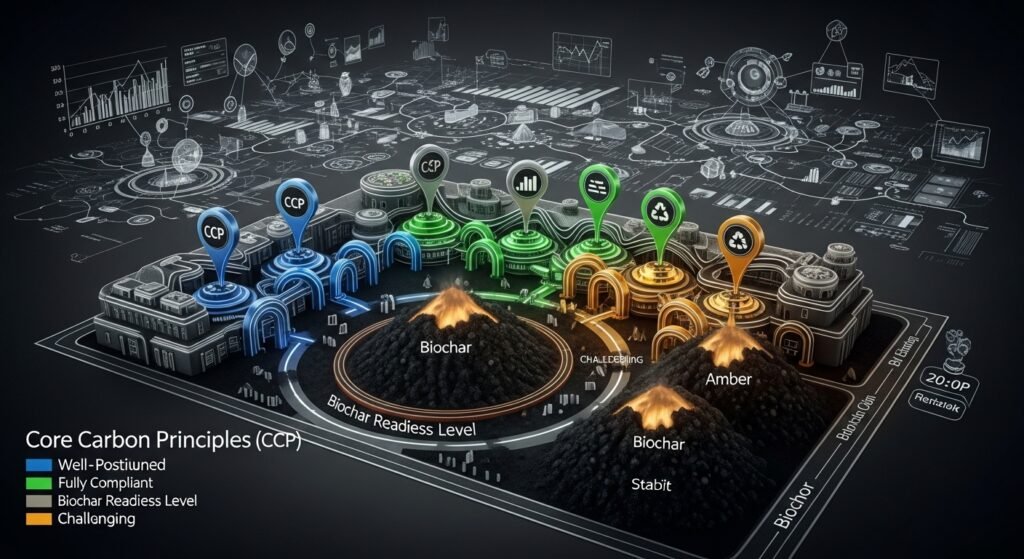
Quantified and Verified: Biochar’s carbon content can be directly measured using established analytical methods (elemental analysis, thermogravimetric analysis). Unlike forestry projects that rely on growth models and sampling, biochar quantification is based on direct measurement of the final product.
Permanent: This is biochar’s strongest suit. The aromatic carbon structure provides chemical permanence that doesn’t depend on ongoing management or ecosystem stability. Recent studies using advanced analytical techniques confirm minimal decomposition rates over decades.
Unique: Biochar credits represent specific, measurable quantities of carbon sequestered in identifiable locations, with clear chain of custody from feedstock to final application.
The main challenge is ensuring robust monitoring and verification systems, particularly for smallholder applications. However, emerging technologies like blockchain-based tracking, satellite monitoring, and mobile soil testing are making comprehensive verification increasingly feasible and cost-effective.
The EU and U.S. are advancing climate-smart agriculture incentives. Do you see India or Africa building similar policy ecosystems to accelerate biochar adoption?
India and Africa are developing policy frameworks, but with different approaches that reflect their unique agricultural and economic contexts.
India’s approach is emerging through multiple channels. The National Mission for Sustainable Agriculture includes soil health improvement programs that could incorporate biochar. The Pradhan Mantri Krishi Sinchayee Yojana focuses on water use efficiency, where biochar’s water retention properties provide clear benefits. Most importantly, India’s updated Nationally Determined Contribution includes soil carbon sequestration targets that biochar can help achieve.

The key difference is that India is likely to emphasize domestic production using agricultural residues, particularly rice husks and sugarcane bagasse. This addresses both the stubble burning problem in Punjab and Haryana and creates rural employment opportunities. The policy framework will likely combine pollution control mandates with carbon market incentives.
Africa’s approach varies by region, but several countries are developing innovative frameworks. Kenya’s Climate Smart Agriculture Strategy explicitly mentions biochar. Ghana is piloting biochar programs through its Cocoa Board, using cocoa pod husks. South Africa is integrating biochar into its carbon tax framework.
The African approach tends to emphasize smallholder aggregation and community-based production models. This reflects the reality of fragmented land holdings but also creates opportunities for more inclusive value distribution.
The Farmer and the Field – Ground Realities
In regions like Sub-Saharan Africa and South Asia, where agriculture is fragmented, how can biochar projects aggregate farmers at scale without losing credibility in monitoring and reporting?
Successful aggregation in fragmented agricultural systems requires what I call “nested verification” – combining high-tech monitoring at the landscape scale with simplified protocols at the farm scale.
The key is developing hub-and-spoke models where centralized pyrolysis facilities serve multiple farming communities within a 50-100 km radius. This allows for standardized biochar production and quality control while maintaining local feedstock sourcing and application.
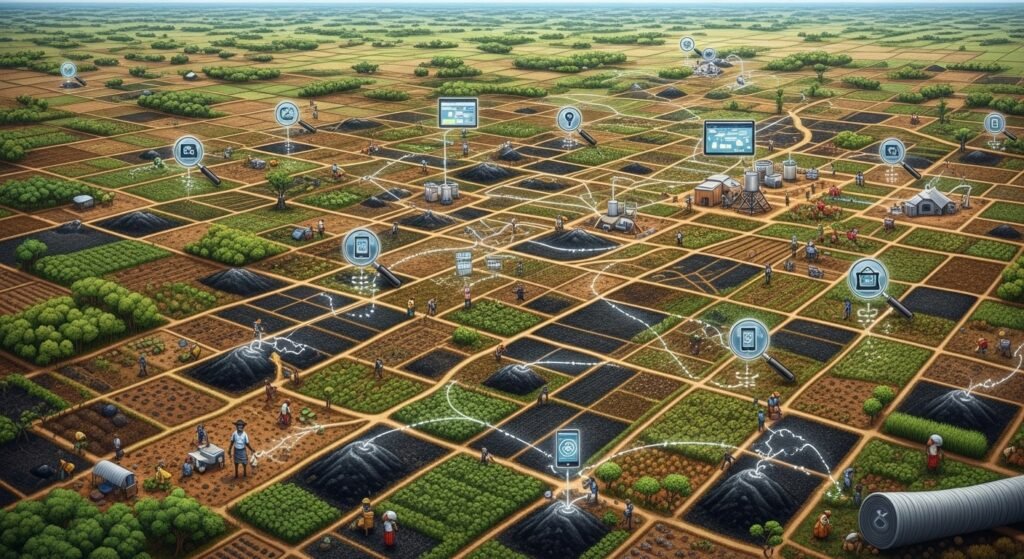
For monitoring and verification, we’re implementing three-tier systems:
Tier 1 – Production Monitoring: Centralized facilities use continuous monitoring systems to track feedstock inputs, pyrolysis conditions, and biochar outputs. This provides precise data on carbon content and production volumes.
Tier 2 – Distribution Tracking: Blockchain-based systems track biochar from production to farm-level application. Farmers receive QR-coded bags that link to specific production batches and carbon content data.
Tier 3 – Application Verification: Satellite monitoring combined with statistical sampling verifies application patterns and soil carbon changes. Mobile soil testing units conduct periodic verification across representative farm plots.
This approach maintains credibility while keeping farmer participation costs low. Farmers don’t need sophisticated monitoring equipment – they simply document application using mobile apps that integrate with the broader tracking system.
Successful examples include the Kenya Agricultural Carbon Project, which aggregates over 60,000 smallholder farmers, and pilot programs in Maharashtra, India, that combine biochar with existing farmer producer organization structures.
Global South Leadership & Geopolitics
Biochar has deep roots in traditional practices like terra preta in the Amazon and tribal methods in India. Can the Global South position biochar not just as a climate tool, but as a cultural and ecological export to global markets?
Absolutely. The Global South has a unique opportunity to position biochar as “indigenous climate technology” – combining traditional knowledge with modern carbon markets to create both economic and cultural value.
Terra preta soils in the Amazon demonstrate biochar’s effectiveness over centuries, providing scientific validation for traditional practices. Similarly, traditional charcoal-making and soil amendment practices across Africa and Asia offer proven implementation models that can be scaled and modernized.

This creates several strategic advantages. First, it positions Global South countries as technology leaders rather than technology recipients. Second, it creates intellectual property opportunities around traditional knowledge systems. Third, it enables premium pricing for “heritage biochar” that combines carbon sequestration with cultural preservation.
The key is developing certification systems that recognize and reward traditional knowledge while ensuring modern monitoring and verification standards. Programs like the Indigenous Carbon Credits initiative in Australia provide models for combining traditional practices with contemporary carbon markets.
From a market positioning perspective, this could create differentiated product categories: “Amazonian terra preta biochar,” “African traditional biochar,” or “Indian tribal biochar” that command premium prices based on cultural heritage and proven effectiveness.
With China, the EU, and the U.S. racing to secure carbon removal pathways, where do you see India and Africa positioning themselves in the global biochar economy?
India and Africa have the potential to become the “Saudi Arabia of biochar” due to abundant biomass resources, low production costs, and growing technical capabilities. However, success requires strategic positioning rather than simply competing on cost.

India’s strategy should focus on becoming the global hub for biochar technology and services. With strong engineering capabilities, abundant agricultural residues, and growing carbon market expertise, India can develop and export both biochar products and production technologies. The key is moving up the value chain from raw biochar production to engineered biochar products, monitoring systems, and project development services.
Africa’s opportunity lies in premium biochar production combined with landscape-scale carbon sequestration programs. African biochar can command premium prices due to high-quality feedstocks, traditional production knowledge, and significant co-benefits for soil restoration and food security. The focus should be on developing regional biochar exchanges and certification systems that capture maximum value.
Both regions should avoid the “resource curse” trap of simply exporting raw materials. Instead, they should develop integrated value chains that include feedstock production, biochar manufacturing, application services, and carbon credit development. This creates local employment while capturing maximum value from the global carbon economy.
The geopolitical dimension is crucial. As developed countries face increasing pressure to achieve net- zero targets, they’ll need massive carbon removal capacity. India and Africa can position themselves as essential partners in global climate goals while building domestic green economies.
Looking Ahead – The Next Decade
If we fast forward to 2035, what would a successful biochar-carbon market ecosystem look like? Widespread farmer adoption? Exchange-traded biochar credits? Integration into national carbon inventories?
By 2035, I envision a mature biochar ecosystem with several key characteristics:
Standardized Production and Trading: Biochar will be traded as a standardized commodity with established quality grades, similar to how agricultural commodities are traded today. Exchange-traded biochar credits will provide price discovery and risk management tools, with futures markets enabling long-term planning.
Integrated Agricultural Systems: Biochar application will be standard practice in regenerative agriculture systems, integrated with precision agriculture technologies. Farmers will receive real-time recommendations on biochar application rates based on soil sensors, satellite data, and AI-driven optimization systems.
National Carbon Accounting: Biochar will be fully integrated into national greenhouse gas inventories and carbon accounting systems. Countries will include biochar sequestration in their NDC reporting, with standardized monitoring and verification protocols.
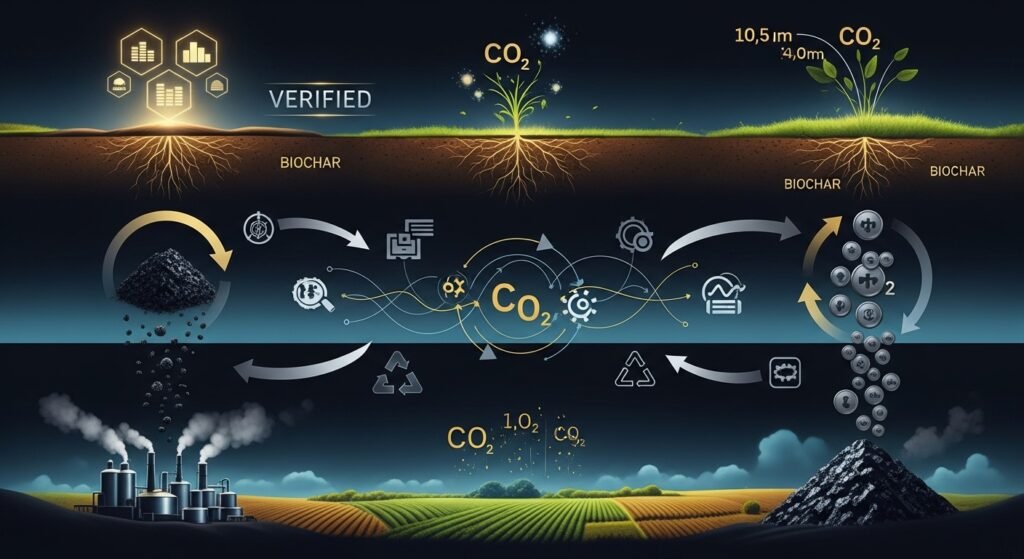
Technology Integration: Advanced pyrolysis systems will be integrated with renewable energy infrastructure, waste management systems, and agricultural processing facilities. Mobile pyrolysis units will serve remote agricultural areas, while large-scale facilities will anchor regional biochar production hubs.
Financial Market Maturation: Biochar projects will access mainstream capital markets through green bonds, carbon credit securitization, and agricultural investment funds. Insurance products will cover production risks, carbon permanence, and agricultural performance.
The successful ecosystem will be characterized by seamless integration across the value chain – from feedstock production through biochar manufacturing, application, monitoring, and carbon credit trading. This integration will create a self-reinforcing cycle where carbon revenues support agricultural productivity improvements, which in turn generate more feedstock for biochar production.
Most importantly, biochar will have evolved from a niche climate solution to a fundamental component of sustainable agriculture and carbon management systems worldwide.
These responses reflect deep technical understanding while addressing the practical realities of scaling biochar in global carbon markets.
—- Suchetana Choudhury (suchetana.choudhuri@agrospectrumindia.com)